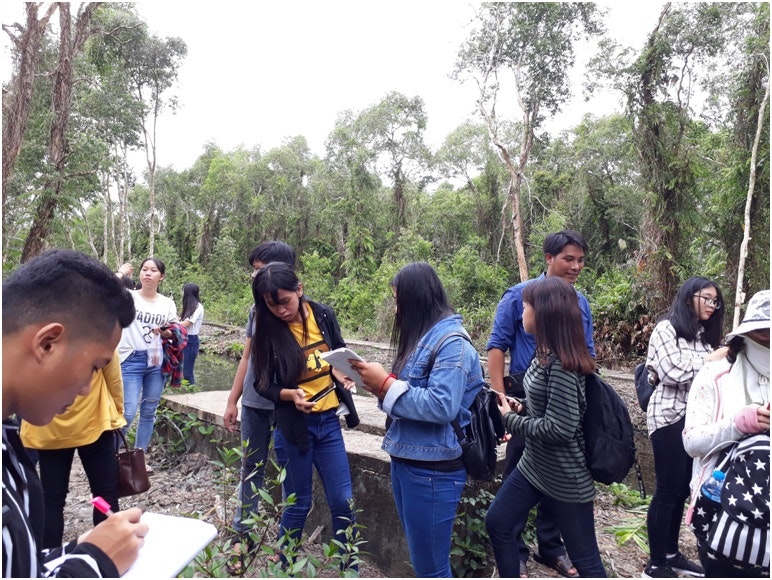New monitor promises data on Mekong depredation
Open data access from satellites and smartphones will build record of environmental change.
The Mekong River’s murky brown water has never hidden the threats from climate change, upstream hydropower dams, sediment starvation, and water level flows. But now a new Mekong Dams Monitor (MDM), bolstered by the Stimson Center’s Mekong Infrastructure Tracker, promises to add needed transparency to observe these ecological problems.
| Mekong River: Source: James Borton and Nguyen Minh Quang |
For nearly three decades, China has been building dams at breakneck speed on the upper Mekong reaches, alarming countries downstream over the threat of Beijing’s control of the water flow.
These open-access database tools offer data visibility and operations monitoring in present and future development projects, especially focused on China’s hydropower dams, enabling the US government and its think tank partners the ability to pinpoint potential Chinese security threats and changes in foreign direct investment (FDI) inflows. For sure, 2020 has brought not only Covid-19 but also record droughts, posing a downstream humanitarian crisis.
The newly announced Monitor underscores the urgency for the adoption of science and technology in the form of remote sensing and satellite imagery directed at the reservoir levels at 13 dams along the river and an additional 15 tributary dams on the lower reaches. The collaborative project originates from the Stimson Center’s program Eyes on Earth Inc. a US research water consultancy and partly funded by the US State Department.
“Data and outputs published on Mekong Dam Monitor complement the ongoing research efforts of organizations in the Mekong, We hope to eventually pass leadership of the platform to collaborative partners in the region and establish lines of official collaboration with the Mekong River Commission,” claims Brian Eyler, a senior fellow at the Washington DC-based Stimson Center and author of Last Days of the Mighty Mekong.
The message behind these open-access database tools is that the US is encouraging the rise of voices and roles from civil society, i.e. grassroots geopolitical agents, who have the capacity and are able to peacefully, yet profoundly, undermine or challenge problematic foreign-owned development projects.
In addition, under the forces of today’s globalization 4.0, data and information appear to outweigh the non-renewable resources. The MDM, MIT and other Western-backed open-data platforms available in the Mekong region shed some light on how the U.S. and its partners are building diverse open sources of information that might constitute a bottom-up and true multi-stakeholder culture in the Mekong region. One question some may ask is in what ways the US agencies and think tanks use and assist international and local actors in employing these open-data platforms and for what purposes?
Broadly speaking, observation and promoting data visibility and transparency informs a localization policy – as part of the recent US Mekong policy. The key aim of this policy is to localize the US influence by supporting local actors to be proactive, more vocal and confident through “data visibility” and “training”. This is a non-confrontational approach that is highlighted in recent cooperation initiatives, including the Mekong-US Partnership.
| A field trip to Mekong River. Source: James Borton and Nguyen Minh Quang |
It is too early to evaluate the impacts of MDM, and other data-driven platforms in the Mekong region. However, these tools are believed to have a few weaknesses. First, given the traditional notion that state leads and all should follow, the accessibility to information in Mekong societies is different from the Western ones. Second, how to translate information from these data tools into simple languages understandable and interesting to the general audience and local peoples throughout the region remains unsettled. Third, data sources contributing to the tools might be questionable. Finally, as long as the information and dataset are widely recognized, they are not a reliable reference sources for policy-planning in the riparian governments.
Downstream in the Lower Mekong Delta, the Mekong Environment Forum in Can Tho, Vietnam has been engaging local farmers in citizen science or community-based science programs. The growth of grassroots participation in environmental issues, and in scientific research in general, has raised both local and international awareness of the transboundary ecosystem dangers.
MEF offers workshops that provide training in open access software for use in smartphones to address upstream environmental challenges. This is urgently needed since current science studies reveal that upstream dams are causing irreparable damage to the delta, altering fragile ecosystems and wrecking the livelihoods of the 2.3 million residents who farm along the Mekong river and the canals in Vietnam’s Mekong Delta.
The internet and new technologies, such as mobile apps for gathering data in the field and cloud storage tools, have made it possible for non-scientists to participate in the production of data and scientific knowledge. Open Development Mekong, a project of the Washington D.C.-based East West Management Institute, as well as the Mekong Water Data Initiative (Mekong Water.org), a program under the umbrella of the U.S.-backed Lower Mekong initiative, are among a few citizen-science platforms working to increase public awareness of the transboundary impacts of Mekong hydropower dams and other environmental challenges.
Science studies, coupled with grassroots participation, empowers communities and provincial government officials with data highlights that upstream hydro-infrastructure developments impact basin flow regime biology, bed and bank stability, biodiversity, fish productivity and sediment and nutrient transport.
The short-term impact of MDM and other data platforms could encourage increasing voices and involvement of non-state actors, such as NGO and grassroots movements, in local green politics. They are on-the-ground sources of information contributing data to the platforms, and change agents representing the US influence. The recent cancelation of some Chinese-backed development projects in Thailand and Myanmar is a visible example of this impact.
It’s encouraging that across the Mekong region more citizen scientists are working to contribute field-based datasets back to various platforms and introducing new policy recommendations and initiatives for a better Mekong future.
With the rising tide of public access to science information and data transparency, the launch of MDM could facilitate the enabling environment of participatory culture in the Mekong sub region where local voices are heard and have the potential to challenge foreign-owned controversial projects.
James Borton is a senior writer who has reported Southeast Asia for several decades and is co-founder of the Mekong Environment Forum. Nguyen Minh Quang is a Lecturer at Can Tho University and a co-founder of the Mekong Environment Forum.
Disclaimer: The views expressed by James Borton and Nguyen Minh Quang are of their own and do not necessarily reflect the views of Hanoitimes.













